During our visit at the Whitney, the only piece to truly capture my attention, so much so that I watched it loop twice, was Anicka Yi’s The Flavor Genome. The short 3D film seemed to have for objective to set up dichotomies, between organic and artificial for example, and then to violently challenge those both through juxtaposing sets of subjects and through a rather monotone narrating talking of genetic mutations and the creation of hybrid creatures for the entertainment of those creating them. Yi would then take her argument further by pinning molecules up against language by discussing Frankenstein-like words created out of a desire for mental shortcuts and which smash together two terms like “sex” and “text” at the risk of losing both original meanings in the process. By doing so she is of course attempting to help move our discussing further by removing the fixed, respectively positive and negative, connotations attached to nature and science. What she’s also effectively doing though is suggesting that pollution is not just something up in the clouds making our cities hotter. There is also an equally real, although more subtle and therefore perhaps more poisonous, kind of pollution which can affect our minds if we are not weary of what ungodly hybrids we birth in our language, and more broadly speaking in our culture. If culture is nature than it is harder to change but it poses the question of who is the apex animal meant to thrive in this environment. If culture is artificial then not only can it be altered at our will but some people amongst can also be held accountable for the atrocities created in the name of culture. In a style reminiscent of body-horror cinema, Yi then shows up glimpses of human hands glossing over skin, wood or metal as if positing the idea that, just like we can break down our language to genes, our selves can be broken down to limbs which, when shown from this point of view, seem to have a will of their own, to be autonomeous. Furthermore she connects living yet seemingly different things through metaphor such as the juxtaposition of a vagina with an octopus and pearls. It seems to suggest that our metaphors can, or do, become our realities. That everytime we compare one thing to another what we are in fact making is a new hybrid. And when we do end up creating that hybrid we henceforth have brought on a new subjectivity to the world. Somehow the film is therefore about creating consciousness for entertainment or subjectivity for consumption. The Liger might’ve been born to please our sight but it is now through his eyes that we wish to see the world and no such eyes had previously existed. Similarly we assembled computers only to slowly, if only through glitch art in the present, birth a new form of consciousness with its own perspective on the reality in which it was born. To return to these hands gliding over surfaces though: I can’t quite explain what I mean by it but if there was to be a message within The Flavor Genome it would seem to be that everything is divisible and that therefore, when shrunken to a sympathetic enough, or weird enough if we’re talking molecular or god forbid quantum level, size then everything is alive.
Uncategorized
The Flavor Genome, Anicka Yi, Whitney Museum
During our class trip to the Whitney Museum of American Art my favorite piece was a 3D video art installation entitled The Flavor Genome. It runs for 22 minutes in a black box space and provides comfortable, plush seating. Some audience members sat upright others lied down. I found that while lying down I was able to deeply feel the reverberation of the bass in that was incorporated into the music of the piece.The music used was current and electronic. I found this refreshing, and I love when a piece of art can reflect back our present reality. This physical sensation was one of my favorite parts of this piece. The story of the film follows a “flavor chemist” on a trip through the Amazon, where she narrates and confronts her fascination and anxiety around the ideas of chemical and genetic engineering and biotechnology. This film was gorgeously shot, but the 3D elements did not add much to the experience overall, but helped to add a futuristic feeling, making the artificial world in front of the screen seem as if I could one day be a reality.This piece had a high production value and it paid off, the cinematography was sharp and clean, and so was the editing. The luxe quality seemed ironic given that so much of the piece was a critique of global consumerism.
The meticulous construction and attention to detail of each scene reminded me of the Netflix show Chef’s Table . The lushness of the Amazon added a certain aesthetic, or shall I say, flavor, that emphasized color and texture.The imagery of this piece was consistently striking, and stayed with me after it ended. The scene of acrylic pink Chanel nails next to a squid head for example, seemed to implant itself in my mind. One of the central themes confronted was the idea of artificiality versus reality and where we draw the line between the two in a world that is increasingly contrived. Everything from our words, foods, and lifestyles have become so hybridized and manipulated that it makes it seem as if nothing is truly real.
.
Liquor Store Theater
At the Witney Museum, an artist named Maya Stovall displayed three video pieces that are part of the Liquor Store Theater volumes. In each video their is one to three people performing a dance near or in front of a liquor store. It cuts between a dance performance to interviews of people part of the Detroit community. The element of dance in the videos seem a bit odd at first but one pedestrian explains the importance of music and dance and how it brings a community together. The pedestrian explains how music and dance can be like therapy. Art is a big part of the community, their are lots of graffiti and murals.
Pedestrians that are interviewed are asked about Detroit. The pedestrians talk about the past and the possible future of their home. Many of the interviewees discussed the changing of the city. The city is getting new stores and building new housing infrastructures. The pedestrians are asked about why people are being moved out. They worry that the new improvements might force poor people out like gentrification in New York. One couple explained how their rent had not risen but the building next to their did and many of those people how to move out.
The series felt that it was trying to bring awareness of the issues of gentrification. It was giving close first half accounts of those people experience the change in their neighborhoods. It also allowed people to talk about what their neighborhood is really like and combat a stigma or stereotype. One pedestrian explained although many go to the liquor store in his community. The liquor store has many other convinces like water and snacks. Having people from the community talk about issues that effect them allows for a perspective that isn’t show on television or a news article. I think it creates empathy and put a face to people being affected by the changes happening in Detroit.
The location of the shooting and dancing I thought was combating a stigma. A lot of liquor stores come to poorer neighborhoods. I felt like it showed that although people are coming in and out of the store. These same people are fully aware of life and politics around them. They are involved and aware of how their communities are changing. They have worries about being forced out of their community and they know that this is happening to them. One of the interesting things when watching people speak was no one knew how to deal or combat the problems. They seemed to accept the changes and the possible future outcome of their home. I felt it showed how as citizens we don’t feel like we can make a change or difference.
Ian Cheng : Emissaries
I went to MoMA PS1 to see Ian Cheng : Emissaries. Emissaries is Ian Cheng’s first US museum solo presentation. This was a live simulation works using a video game which was very interesting.
There was a 10-foor-tall projection on the wall “Positioning viewers as observers who can follow the lives of specific characters as they interact within the simulated worlds and each other in an ever-changing environment.” The exhibition was collaborated with Twitch; the world’s leading video platform and community for gamers. This exhibition was popular for gamers because the exhibition made viewers to feel that they are in the video game world. When I first saw the Emissaries, I was very confusing because I am not a gamer. However, when I stayed in front of the screen and watched few minutes, I felt like I am at the inside of the screen. The video game wasn’t video game that we familiar so it didn’t look like a video game but it made viewers to involve the screen. There were lots of characters talking each other and it felt like I am one of the character. The one thing that left a lot to be desired was character’s conversation. There was a dialogue which was not English. Since the language was video game language it was difficult to understand character’s dialogue. It would be much better if the viewers could understand the dialogue. However, the dialogue was not a big problem. There was a background sound that made more realistic. I felt like I am at the screen because of the realistic sound. The one thing I really liked about the screen was that the simulation works using a video game made the viewers to involve with the simulation. Some screen showed very closer to the characters so it made me like I am next to these characters. Some screen showed flying scene with the point of view so it made the viewers flying. Just watching the screen didn’t make the viewers to involve the screen because of the video game scene. However, Ian Cheng used lot of different simulations so it made the viewers to involve with the screen easily. Even though, I couldn’t understand dialogue from the screen, I was able to involve with the screen because of the simulation and the background sound.
I really liked this exhibition because I have never seen exhibition like this before. Also, it was really interesting that video game can become an art. I learned that the viewers can understand and the viewers can involve to the screen with only the visual.
Palais de Tokyo, Taro Izumi
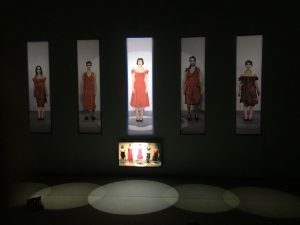
Over spring break I was fortunate to have the opportunity to visit one of my best friends in her place of residence, Paris. While there I dragged her to the many art museums and galleries the city had to offer.
Palais de Tokyo is a museum with a concentration on video art, installation, performance, and mixed-media. If the artist used a medium traditionally represented in art institutions, the artist transcended the form of the medium and used the medium’s base materials to address the formal qualities and assumptions of said medium. Another quality of this museum that I found antithetical to the typical credo of art institutions was an allowance for the viewer to come within close proximity of the piece. Pieces either had lenient boundaries or were constructed around the notion of audience interaction.
The most notable installation at Palais de Tokyo was a video, multi-media, and sculpture installation by Taro Izumi entitled Pan. This installation encompassed three large interlocking rooms. What especially struck me about this installation was how the three rooms interacted with each other both in terms of spatial and temporal relations. Even before walking through the dark entrance to the installation one already hears humans howling. The first thing one sees in the exhibit is a lone television screening a video of a boy standing in front of a white wall howling. He is but one of a chorus of howlers still to be found. Behind the television is a black wall with a projection of a cartoon brick wall flickering in and out.
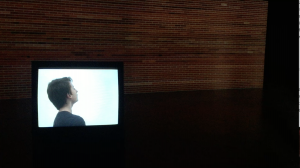
Whitney Museum of American Art
Whiney Museum is always a fascinating place to visit. It was the third trip I took down to the Meatpacking District to see this beautiful piece of architecture. This is the kind of place where one can expect to spend hours in just one room. I tried to keep myself from doing that, however, there’s been some interesting pieces that just demanded attention for me put together the pieces that make them tick. For this reason, along with the fact that they all collectively serve their purpose the way they’re intended, I can’t pick just one work to place on the top shelf and call it my favorite. I could, however, pick one thing about the museum over the others! Just the sheer amount of young people inside, whether they’d be taking pictures, or sketching an art piece on their notebooks; or a guide asking a bunch of middle school students “What does graphic design mean?” were all endearing. I managed to take pictures of most of those happening, also shoot a few clips and edited them into a piece of timelapse video. I feel like places like Whitney, Guggenheim, and MoMA need to be visited at least once a year.
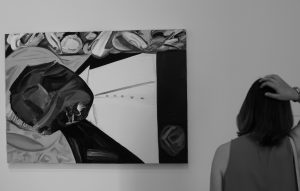
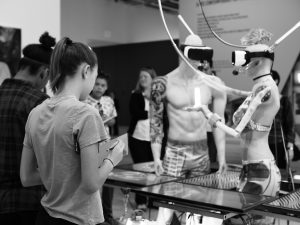
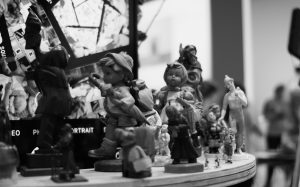
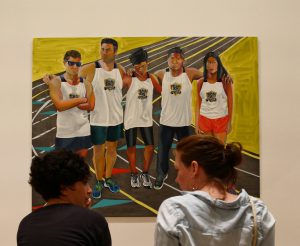
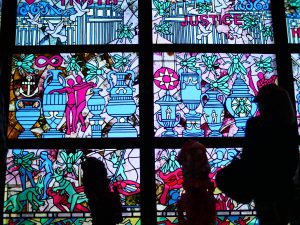
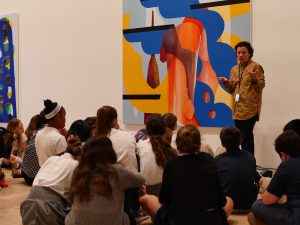
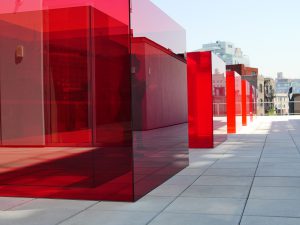
Sex Ed By God
During the class trip to the 2017 Biennial at the Whitney Museum, I saw many fascinating works of art and film. One of the films that stood out to me the most was Tala Madani’s Sex Ed By God. I found this short piece really interesting. Tala Madani is an Iranian artist, who had multiple pieces of art at the Whitney Biennial, mostly focusing on genitalia. Sex Ed By God is a 2 minute animation which features a young looking female who is being projected on a screen while a pair of lips “God” ramble about sex, while two other men in the room look on, one older one seems to be a child. The pair of floating lips speaks in a heavy breathed voice and seems to be speaking about advice of stimulating a woman rather than typical sex ed classes.The men are staring at this woman on a screen, the words coming out of the lips are at times gibberish and not entirely clear
The part I like the best is how these two men and God are looking and talking about this female who is being projected on the screen, but then she reaches out of the screen and smooches the three of them in her hand and put them inside of her vagina. To me it is the moment when the woman takes control and power over the men who have been watching her this whole time. She then erases the screen she is on, taking herself off the screen and no longer an object to watch.
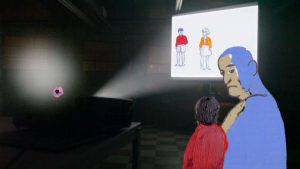
Whitney Biennial 2017
Unfortunately, I wasn’t able to go to the Whitney Museum trip with the class last Friday because of allergies. However, I really wanted to go visit the Whitney Biennial, and just the Museum itself because I heard its a MUST GO place. A lot of my friends know and have been to the Whitney, but I’ve never been there before. So, I decided to go on my own this week and it was a great decision.
First off, the building itself is a work of art. It has all these different dimensions and huge windows that give sneak peeks of the wonderful works inside. Also, it’s a plus that I was able to go in for free with a Student ID. The Whitney Biennial was quite overwhelming. There were floors and floors of arts displayed. They were all unique and beautiful, but I’m not going to lie. I wasn’t a fan of everything.
I love films and visuals with motion, but I’m also a huge sucker for paintings, sculptures, and photographs. Something about still framed arts make me think harder, feel deeper about them. One of the pieces I found capturing was a painting called Elevator. The painter is Dana Schutz. I really love this piece. It’s so detailed with different colors and textures. So many things are going on with so many different people, and yet, they’re all forced to be in this space to get to a specific destination. When I think about elevators, I feel like my time within that space is frozen. It’s a mindless ride. But for the time I’m on the elevator with the many people inside of it, too, I feel like, for that moment in time, everyone in it has the same goal, same feelings, same thoughts about whether the elevator will fall and our lives will end together, and just sharing a specific moment of being there together. Also, elevators are this closed space where anyone in it knows everything going on inside, while everyone outside has no clue. Playing with the use of privacy and being “revealed” to the public, almost like all of today’s hidden government issues, and even metaphorically like our hearts being closed and hidden of its chaos and brokenness. I feel like I’m babbling, but I’m sure I was going somewhere with this. Elevator is “that deep” for me. It just gets me thinking more and more. Just amazing!
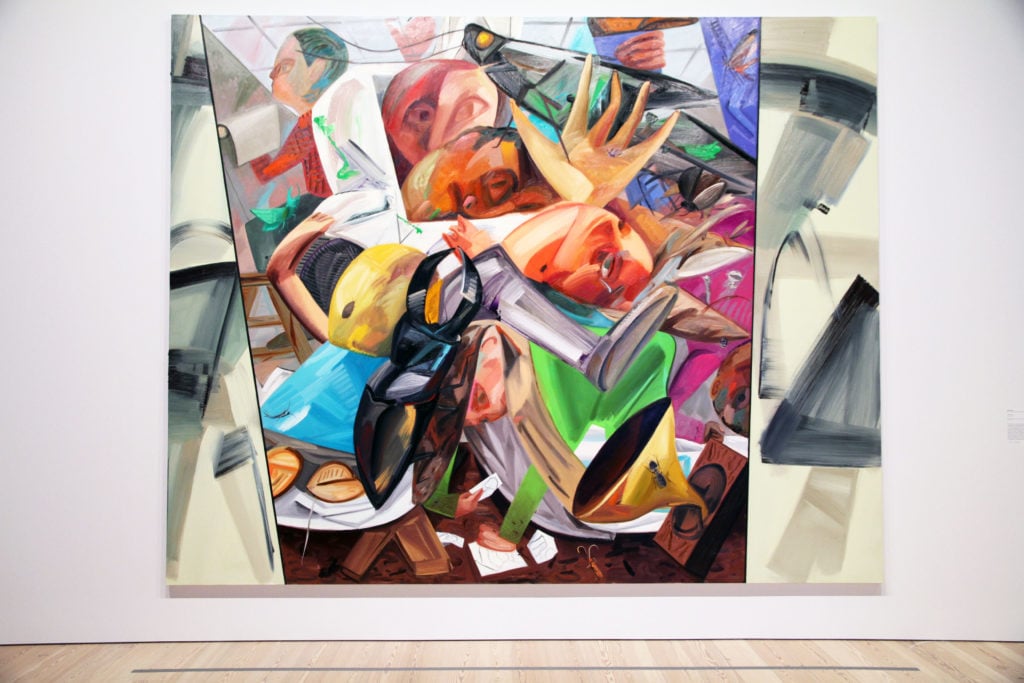
As for film, I really enjoyed The Lesser Key of Solomon by Tommy Hartung. The reason why I really like this film was because of all the use stop-motion animations and just the overall color of the film. I read that Hartung created this film to capture this “hallucinatory reflecting themes of racial inequality, power struggles, systemic violence, and religious fervor”. Basically, it has A LOT going on in it. Although, I’m not a fan of dark demonic magic or anything the first part of the film talks about. I solely enjoyed this piece because of the aesthetically aspect of it. Stop-motion was a great touch to really give that distorted, breaky, unsettling feeling, which is something we feeling when we talk about “racial inequality, power struggles, systemic violence, and religious fervor”.

Whitney Biennial was very very interesting and I’ll definitely recommend more people to go before the exhibition ends! Maybe I’ll go again and maybe I’ll see new things I haven’t realized my first time there.
Whitney Museum Trip by Lucas Chang
Whitney Museum Trip
Overall, this was my second trip to the Whitney Museum since I went with one of my other classes last year. However, I one hundred percent feel that my second visit was way more interesting than my first time in the Museum. This was because my first time at the Museum, we weren’t allowed to separate from the group and explore different works of art all around the museum, which made the first trip less exciting for me. Since we were able to explore on our own this time around, I was able to see more exhibits and have a much better time.
One of the exhibits that I saw was a small room that had eight walls with baloney slices on them. Each slice had a face of a Jewish person in the center. Overall there are at least 2,755 Jewish faces on these 8 walls of baloney, which according to the New York Times and the Wall Street Journal is about twenty five percent of the total amount of Jewish citizens living in New York City to this very day. I found this interesting and fascinating because it was my first time that I saw a unique art exhibit was made based off facts about New York City. After I saw this exhibit, I had left feeling like I learned something new about the city that I grew up in.
Another exhibit that was enamored with was a small screening about a two Filipinos one men and one women leaning on each other in order to survive on an island. The man was seen saving the Filipino women by pulling her out of the water. The screening goes on to show the Filipino man describing some facts and information about the island to the Filipino women, to help her understand more about where she is. I felt that this screening was interesting because it showed how two people are trying everything they can to survive on a remote island away from civilization, with both of them only knowing so much about the island they are on.
One last exhibit that I found very interesting consisted of a small room with four walls that showed gates and fences on each wall which imitated the Mexican border. As you stay in the room, you hear train noises and cars and trucks driving by the Mexican borders through the gates and fences that are displayed on the wall. I felt this exhibit was interesting because I got to see what the Mexican border looks like for those who are trying to get into the United States or whoever is leaving the country.
In conclusion, my trip to the Whitney Museum was a much better experience than my first time at the museum since we were able to see different works of art and learn. I was able to have a much more enjoyable experience and even learned something new about my city that I never knew before. Overall I enjoyed my experience at the Whitney Museum.
A Very Long Line
In our visit to the Whitney Biennial there was a piece I enjoyed because of the way it was shown. The piece was called A Very Long Line by Postcommodity which is a production team of Raven Chacon, Cristobal, and Kade L. Twist. The piece focuses on the border between the United States and Mexico which has been a big topic in our current political picture. The video was shown in a small room. There were four projectors each pointed at a different wall. It was filmed inside a moving car. All you see is grass and landscape behind bars and railing. The piece made me feel trapped behind all those bars but the sounds also were disorienting. It was so loud in there, all you hear is wind and breeze as the car travels along the rail. You also hear the passing of other cars as you would on a highway. Each projector showed a different video which was a different part of the border. The videos also played at different speeds so if you were looking at the video in front of you per say, it might be moving faster then the two videos to your left and right. This difference of speed affected your peripheral vision and made the video in front of you seem as if it were really moving. You actually for a quick second could feel transplaced into the area. The installation was designed to disorient which I thought it did really well. It also was designed to create a sort of amnesia feeling or condition to evoke this idea of forgetting ones origins. The origins being forgotten mostly by United States citizens the Indigenous status of people from the Western Hemisphere.
This piece got me thinking of the differences between a gallery installation and a piece that is shown in theater. It got me questioning if this piece would work and give the same feeling if it were shown in a theater and to answer my own question it wouldn’t. What makes the piece work in creating this atmosphere is that being surrounded by the four projectors displaying this video creates a disorienting feeling. If displayed only one screen I don’t think the piece would evoke the same feeling.
This is a link to the piece I found on youtube, you get a better sense of what I was describing but the effect is more moving in person.